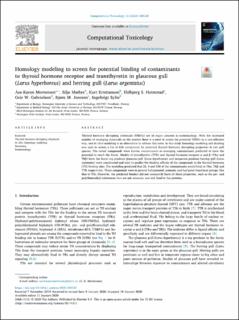| dc.contributor.author | Mortensen, Åse-Karen | |
| dc.contributor.author | Mæhre, Silje | |
| dc.contributor.author | Kristiansen, kurt | |
| dc.contributor.author | Heimstad, Eldbjørg Sofie | |
| dc.contributor.author | Gabrielsen, Geir W. | |
| dc.contributor.author | Jenssen, Bjørn Munro | |
| dc.contributor.author | Sylte, Ingebrigt | |
| dc.date.accessioned | 2020-03-13T12:32:37Z | |
| dc.date.available | 2020-03-13T12:32:37Z | |
| dc.date.created | 2020-03-01T15:46:06Z | |
| dc.date.issued | 2020 | |
| dc.identifier.citation | Computational Toxicology. 2020, 13, 100120. | en_US |
| dc.identifier.issn | 2468-1113 | |
| dc.identifier.uri | https://hdl.handle.net/11250/2646744 | |
| dc.description.abstract | Thyroid hormone disrupting chemicals (THDCs) are of major concern in ecotoxicology. With the increased number of emerging chemicals on the market there is a need to screen for potential THDCs in a cost-efficient way, and in silico modeling is an alternative to address this issue. In this study homology modeling and docking was used to screen a list of 626 compounds for potential thyroid hormone disrupting properties in two gull species. The tested compounds were known contaminants or emerging contaminants predicted to have the potential to reach the Arctic. Models of transthyretin (TTR) and thyroid hormone receptor α and β (TRα and TRβ) from the Arctic top predator glaucous gull (Larus hyperboreus) and temperate predator herring gull (Larus argentatus) were constructed and used to predict the binding affinity of the compounds to the thyroid hormone (TH) binding sites. The modeling predicted that 28, 4 and 330 of the contaminants would bind to TRα, TRβ and TTR respectively. These compounds were in general halogenated, aromatic and had polar functional groups, like that of THs. However, the predicted binders did not necessarily have all these properties, such as the per- and polyfluoroalkyl substances that are not aromatic and still bind to the proteins. | |
| dc.language.iso | eng | en_US |
| dc.rights | Navngivelse 4.0 Internasjonal | * |
| dc.rights.uri | http://creativecommons.org/licenses/by/4.0/deed.no | * |
| dc.title | Homology modeling to screen for potential binding of contaminants to thyroid hormone receptor and transthyretin in glaucous gull (Larus hyperboreus) and herring gull (Larus argentatus) | en_US |
| dc.type | Peer reviewed | en_US |
| dc.type | Journal article | en_US |
| dc.description.version | publishedVersion | en_US |
| dc.rights.holder | © 2020 The Authors. Published by Elsevier B.V. | en_US |
| dc.source.volume | 13 | en_US |
| dc.source.journal | Computational Toxicology | en_US |
| dc.identifier.doi | 10.1016/j.comtox.2020.100120 | |
| dc.identifier.cristin | 1798751 | |
| dc.relation.project | NILU: 117055 | |
| dc.relation.project | Norges forskningsråd: 268419 | |
| cristin.ispublished | true | |
| cristin.fulltext | original | |
| cristin.qualitycode | 1 | |

